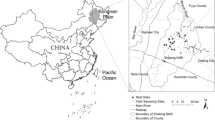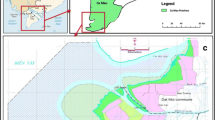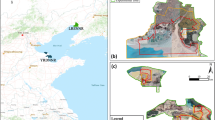Abstract
This study aims to assess the relative importance of natural and anthropogenic variables on the change of the red-crowned crane habitat in the Yellow River Nature Reserve, East China using multitempopral remote sensing and geographic information system. Satellite images were used to detect the change in potential crane habitat, from which suitable crane habitat was determined by excluding fragmented habitat. In this study, a principal component analysis (PCA) with seven variables (channel flow, rainfall, temperature, sediment discharge, number of oil wells, total length of roads, and area of settlements) and linear regression analyses of potential and suitable habitat against the retained principal components were applied to explore the influences of natural and anthropogenic factors on the change of the red-crowned crane habitat. The experimental results indicate that suitable habitat decreased by 5,935 ha despite an increase of 1,409 ha in potential habitat from 1992 to 2008. The area of crane habitat changed caused by natural drivers such as progressive succession, retrogressive succession, and physical fragmentation is almost the same as that caused by anthropogenic forces such as land use change and behavioral fragmentation. The PCA and regression analyses revealed that natural factors (e.g., channel flow, rainfall, temperature, and sediment discharge) play an important role in the crane potential habitat change and human disturbances (e.g., oil wells, roads, and settlements) jointly explain 51.8 % of the variations in suitable habitat area, higher than 48.2 % contributed by natural factors. Thus, it is vital to reduce anthropogenic influences within the reserve in order to reverse the decline in the suitable crane habitat.






Similar content being viewed by others
References
Bi, X. L., Wang, B., & Lu, Q. S. (2011). Fragmentation effects of oil wells and roads in the Yellow River Delta, North China. Ocean & Coastal Management, 54, 256–264.
Bird Life International (2012). Grus japonensis and G. vipio. In IUCN 2012. IUCN red list of threatened species. Version 2012.1. http://www.iucnredlist.org. Accessed 9 Jul 2012.
Cao, M. C., & Liu, G. H. (2008). Habitat suitability change of red-crowned crane in Yellow River Delta Nature Reserve. Journal of Forestry Research, 19, 141–147.
Cui, S. Q. (2002). Influence of water discharge cut-off of Huanghe on environment of its delta. Marine Sciences, 26, 42–46.
Cui, B. S., Yang, Q. C., Yang, Z. F., & Zhang, K. J. (2009). Evaluating the ecological performance of wetland restoration in the Yellow River Delta, China. Ecological Engineering, 35, 1090–1103.
Day, J. W., Shaffer, G. P., Britsch, L. D., Reed, D. J., Hawes, S. R., & Cahoon, D. (2000). Pattern and process of land loss in the Mississippi Delta: a spatial and temporal analysis of wetland habitat change. Estuaries and Coasts, 4, 425–438.
Deffontaine, J. P., Thenail, C., & Baudry, J. (1995). Agricultural systems and landscape patterns: how can we build a relationship? Landscape and Urban Planning, 31, 3–10.
Ferrier, S. (2002). Mapping spatial pattern in biodiversity for regional conservation planning: where to from here. Systems Biology, 51, 331–363.
Fleury, A. M., & Brown, R. D. (1997). A framework for the design of wildlife conservation corridors with specific application to southwestern Ontario. Landscape and Urban Planning, 37, 163–186.
Forman, R. T. T. (1997). Land mosaics. Cambridge: Cambridge University Press.
Forman, R. T. T., & Godron, M. (1985). Landscape ecology. New York: Wiley.
Gottschalk, T. K., Huettmann, F., & Ehlers, M. (2005). Thirty years of analyzing and modeling avian habitat relationships using satellite imagery data: a review. International Journal of Remote Sensing, 26, 2631–2656.
Halpern, S. (1992). Losing ground. Audubon, 7, 70–79.
Harris, J. (1997). Future for China’s cranes. ICF Bugle, 23, 1–3.
Hijmans, R. J., & Graham, C. H. (2006). The ability of climate envelope models to predict the effect of climate change on species distributions. Global Change Biology, 12, 2272–2281.
Hu, C. H., & Cao, W. H. (2003). Variation, regulation and control of flow and sediment in the Yellow River Estuary: I. Mechanism of flow-sediment transport and evolution. Journal of Sediment Research, 5, 1–8.
Hu, Y. M., & Xiao, D. N. (1999). Behavioral fragmentation of waterfowl habitat and its landscape ecological design in Shuangtai-hekou Reserve, Liaoning, China. Journal of Environmental Sciences, 11, 231–235.
Indrawan, M., & Wirakusumah, S. (1995). Jakarta urban forest as bird habitat: a conservation view. Tiger Paper, 22, 29–32.
Jiang, H. X., Qian, F. W., Liu, C. Y., Li, X. M., Hou, Y. Q., Zhang, G. G., et al. (2012). Impact of marsh changes on breeding cranes in Sanjiang Plain, northeastern China. Chinese Birds, 3, 165–179.
Lee, S. D., Jablonski, P. D., & Higuchi, H. (2007). Winter foraging of threatened cranes in the Demilitarized Zone of Korea: behavioral evidence for the conservation importance of unplowed rice fields. Biological Conservation, 139, 286–289.
Letnic, M. I., & Fox, B. J. (1997). The impact of industrial fluoride fall out on faunal succession following sand mining of dry sclerophyll forest at Tomago, NSW.—I. Lizard recolonisation. Biological Conservation, 80, 63–81.
Li, F., Yang, H. J., Zhang, H. H., & Gao, Z. X. (1999). The nest-site selection by red-crowned crane in the Zhalong wetland. Journal of Northeast Forestry University, 27(6), 57–60.
Li, S. N., Wang, G. X., Deng, W., Hu, Y. M., & Hu, W. W. (2009). Influence of hydrology process on wetland landscape pattern: a case study in the Yellow River Delta. Ecological Engineering, 35, 1719–1726.
Li, M. Y., Zhang, C. Y., Wu, J., & Xu, T. (2012). Vegetation dynamics analysis in northeastern breeding habitat of Grus japonensis under scenarios of climate warming. Journal of Central South University of Forestry & Technology, 32, 58–63.
Liu, G. H., & Drost, H. J. (1997). Atlas of the Yellow River delta. The Publishing Housing of Surveying and Mapping, Beijing.
Liu, C. Y., Jiang, H. X., Hou, Y. Q., Zhang, S. Q., Su, L. Y., Li, X. F., et al. (2010). Habitat changes for breeding waterbirds in Yancheng National Nature Reserve, China: a remote sensing study. Wetlands, 30, 879–888.
Ma, Z. J., Wang, Z. J., & Tang, H. G. (1999). Habitat use and selection by red-crowned crane Grus japonensis in winter in Yancheng Biosphere Reserve, China. Ibis, 141, 135–139.
Ma, Z. J., Li, W. J., & Wang, Z. J. (2000). The natural conservation of red-crowned crane. Beijing: Tsinghua University Press.
Nagendra, H. (2001). Using remote sensing to assess biodiversity. International Journal of Remote Sensing, 22, 2377–2400.
Peng, J., Chen, S. L., & Dong, P. (2010). Temporal variation of sediment load in the Yellow River basin, China, and its impacts on the lower reaches and the river delta. Catena, 83, 135–147.
Pimm, S. L., & Raven, P. (2000). Biodiversity–extinction by numbers. Nature, 403, 843–845.
Prugh, L. R., Hodges, K. E., Sinclair, A. R. E., & Brashares, J. S. (2008). Effect of habitat area and isolation on fragmented animal populations. PNAS, 105, 20770–20775.
Ricklefs, R. A. (2004). Comprehensive framework for global patterns in biodiversity. Ecology Letters, 7, 1–15.
Rushton, S. P., Ormerod, S. J., & Kerby, G. (2004). New paradigms for modeling species distributions. Journal of Applied Ecology, 41, 193–200.
Sala, O. E., Chapin, F. S., Armesto, J. J., Berlow, E., Bloomfield, J., Dirzo, R., et al. (2000). Global biodiversity scenarios for the year 2100. Science, 287, 1770–1774.
Shu, Y., Hu, Y. M., Guo, D. F., Shan, K., Zhu, S. Y., & Wang, L. D. (2004). The change of habitat suitable for the red-crowned crane in Yellow River Delta. Chinese Journal of Zoology, 39, 33–41.
Shu, Y., Hu, Y. M., Leng, W. F., Zhu, Y. S., & Shan, K. (2006). Habitat selection of red-crowned crane in Yellow River Delta. Chinese Journal of Ecology, 8, 954–958.
Smirenski, S. M. (1988). Chick relationships and brood sizes in red-crowned (Grus japonensis) and white-napped (Grus vipio) cranes. In N. M. Litvinenko & I. A. Neufeldt (Eds.), The Palearctic cranes. Vladivostok: Amur–Ussuri Branch of the USSE Ornithological Society.
Suchanek, T. H. (1996). Temperate coastal marine communities: biodiversity and threats. Biological Conservation, 76, 210–211.
Wan, D. M., Gao, W., Wang, Q. Y., Wang, H. T., & Liu, M. Y. (2002). Effects of habitat fragmentation on nesting site selection of red-crowned crane. Chinese Journal of Applied Ecology, 13(5), 581–584.
Wang, Q. S. (2008). Threats for red-crowned crane. China Crane News, 12, 7–12.
Wang, S., Hassan, M., & Xie, X. (2006). Relationship between suspended sediment load, channel geometry and land area increment in the Yellow River Delta. Catena, 65, 302–314.
Wang, H. J., Yang, Z. S., Saito, Y., Liu, J. P., Sun, X. X., & Wang, Y. (2007). Stepwise decreases of the Huanghe (Yellow River) sediment load (1950–2005): Impacts of climate change and human activities. Global and Planetary Change, 57, 331–354.
Wang, X., Zhang, J., & He, R. (2011). A strategy to deal with water crisis under climate change for mainstream in the middle reaches of Yellow River. Mitigation and Adaptation Strategies for Global Change, 16, 555–566.
Wang, H., Gao, J., Ren, L. L., Kong, Y., Li, H., & Li, L. (2013). Assessment of the red-crowned crane habitat in the Yellow River Delta Nature Reserve, East China. Regional Environmental Change, 13(1), 115–123.
Wei, F., Feng, Z., & Wang, Z. (1999). Current distribution, status and conservation of wild red pandas Ailurus fulgens in China. Biological Conservation, 89, 285–291.
Wilcox, B. A., & Murphy, D. D. (1985). Conservation strategy: the effects of fragmentation on extinction. American Naturalist, 125, 879–887.
Wu, Q. M., & Zou, H. F. (2011). Nest–site selection pattern of Grus japonensis in Zhalong Nature Reserve of northeast China. Journal of Forestry Research, 22, 281–288.
Xiao, D. N., Hu, Y. M., & Li, X. Z. (2001). Landscape ecology research at wetland surrounding Bohai sea delta. Beijing: China Science.
Xu, X. G., Guo, H. H., Chen, X. L., Lin, H. P., & Du, Q. L. (2002). A multi-scale study on land use and land cover quality change: the case of the Yellow River Delta in China. GeoJournal, 3, 177–183.
Yue, T. X., Xu, B., & Liu, J. Y. (2004). A patch connectivity index and its change in relation to new wetland at the Yellow River Delta. International Journal of Remote Sensing, 25, 4617–4628.
Yvonne, C. A., Brady, R. C., & John, A. B. (2012). Using multitemporal remote sensing imagery and inundation measures to improve land change estimates in coastal wetlands. Estuaries and Coasts, 35, 190–200.
Zhang, Y. H., Deng, W., & Zhang, S. W. (2006). The spatial structure analysis of the red-crown crane’s habitat in Xianghai National Nature Reserve based on RS and GIS techniques. Acta Ecologica Sinica, 26, 3725–3731.
Zhao, Y. M., & Song, C. S. (1995). Scientific survey of the Yellow River Delta Nature Reserve. Beijing: China Forestry Press.
Acknowledgments
The research was supported by the National Science Foundation of China (40871230), State Key Laboratory of Resources and Environmental Information System, and 111 Project Ministry of Education and State Administration of Foreign Experts Affairs of China (B08048).
Author information
Authors and Affiliations
Corresponding author
Rights and permissions
About this article
Cite this article
Wang, H., Gao, J., Pu, R. et al. Natural and anthropogenic influences on a red-crowned crane habitat in the Yellow River Delta Natural Reserve, 1992–2008. Environ Monit Assess 186, 4013–4028 (2014). https://doi.org/10.1007/s10661-014-3676-y
Received:
Accepted:
Published:
Issue Date:
DOI: https://doi.org/10.1007/s10661-014-3676-y




